Stephen McCrory
Stability-Aware Retargeting for Humanoid Multi-Contact Teleoperation
Oct 05, 2025Abstract:Teleoperation is a powerful method to generate reference motions and enable humanoid robots to perform a broad range of tasks. However, teleoperation becomes challenging when using hand contacts and non-coplanar surfaces, often leading to motor torque saturation or loss of stability through slipping. We propose a centroidal stability-based retargeting method that dynamically adjusts contact points and posture during teleoperation to enhance stability in these difficult scenarios. Central to our approach is an efficient analytical calculation of the stability margin gradient. This gradient is used to identify scenarios for which stability is highly sensitive to teleoperation setpoints and inform the local adjustment of these setpoints. We validate the framework in simulation and hardware by teleoperating manipulation tasks on a humanoid, demonstrating increased stability margins. We also demonstrate empirically that higher stability margins correlate with improved impulse resilience and joint torque margin.
Humanoid Locomotion and Manipulation: Current Progress and Challenges in Control, Planning, and Learning
Jan 03, 2025



Abstract:Humanoid robots have great potential to perform various human-level skills. These skills involve locomotion, manipulation, and cognitive capabilities. Driven by advances in machine learning and the strength of existing model-based approaches, these capabilities have progressed rapidly, but often separately. Therefore, a timely overview of current progress and future trends in this fast-evolving field is essential. This survey first summarizes the model-based planning and control that have been the backbone of humanoid robotics for the past three decades. We then explore emerging learning-based methods, with a focus on reinforcement learning and imitation learning that enhance the versatility of loco-manipulation skills. We examine the potential of integrating foundation models with humanoid embodiments, assessing the prospects for developing generalist humanoid agents. In addition, this survey covers emerging research for whole-body tactile sensing that unlocks new humanoid skills that involve physical interactions. The survey concludes with a discussion of the challenges and future trends.
Mixed Reality Teleoperation Assistance for Direct Control of Humanoids
Nov 01, 2024Abstract:Teleoperation plays a crucial role in enabling robot operations in challenging environments, yet existing limitations in effectiveness and accuracy necessitate the development of innovative strategies for improving teleoperated tasks. This article introduces a novel approach that utilizes mixed reality and assistive autonomy to enhance the efficiency and precision of humanoid robot teleoperation. By leveraging Probabilistic Movement Primitives, object detection, and Affordance Templates, the assistance combines user motion with autonomous capabilities, achieving task efficiency while maintaining human-like robot motion. Experiments and feasibility studies on the Nadia robot confirm the effectiveness of the proposed framework.
High-Speed and Impact Resilient Teleoperation of Humanoid Robots
Sep 06, 2024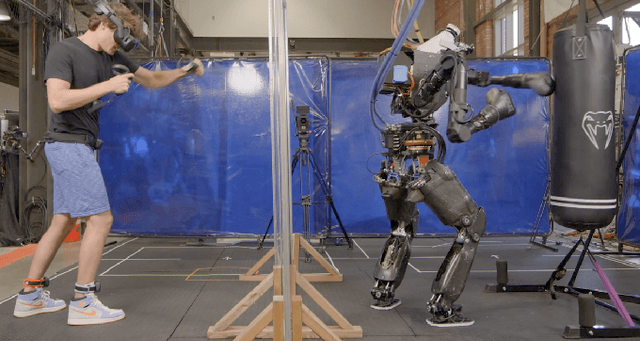
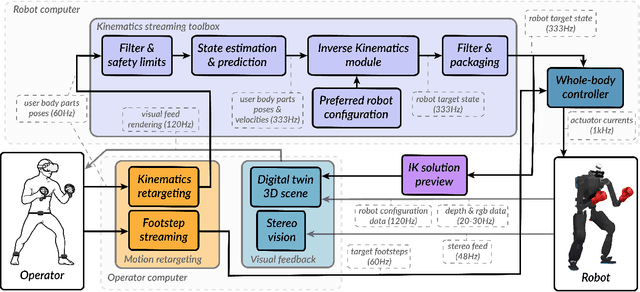
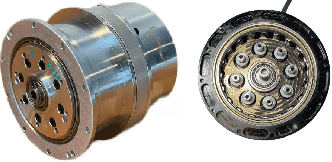
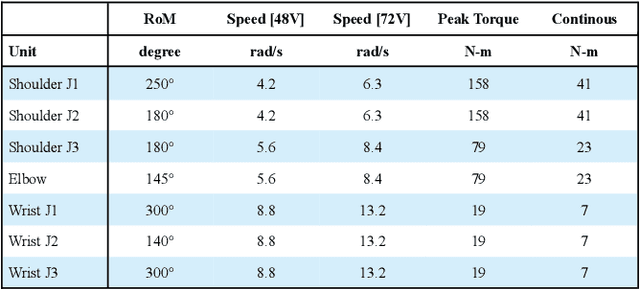
Abstract:Teleoperation of humanoid robots has long been a challenging domain, necessitating advances in both hardware and software to achieve seamless and intuitive control. This paper presents an integrated solution based on several elements: calibration-free motion capture and retargeting, low-latency fast whole-body kinematics streaming toolbox and high-bandwidth cycloidal actuators. Our motion retargeting approach stands out for its simplicity, requiring only 7 IMUs to generate full-body references for the robot. The kinematics streaming toolbox, ensures real-time, responsive control of the robot's movements, significantly reducing latency and enhancing operational efficiency. Additionally, the use of cycloidal actuators makes it possible to withstand high speeds and impacts with the environment. Together, these approaches contribute to a teleoperation framework that offers unprecedented performance. Experimental results on the humanoid robot Nadia demonstrate the effectiveness of the integrated system.
Physically Consistent Online Inertial Adaptation for Humanoid Loco-manipulation
May 13, 2024



Abstract:The ability to accomplish manipulation and locomotion tasks in the presence of significant time-varying external loads is a remarkable skill of humans that has yet to be replicated convincingly by humanoid robots. Such an ability will be a key requirement in the environments we envision deploying our robots: dull, dirty, and dangerous. External loads constitute a large model bias, which is typically unaccounted for. In this work, we enable our humanoid robot to engage in loco-manipulation tasks in the presence of significant model bias due to external loads. We propose an online estimation and control framework involving the combination of a physically consistent extended Kalman filter for inertial parameter estimation coupled to a whole-body controller. We showcase our results both in simulation and in hardware, where weights are mounted on Nadia's wrist links as a proxy for engaging in tasks where large external loads are applied to the robot.
Authoring and Operating Humanoid Behaviors On the Fly using Coactive Design Principles
Jul 25, 2023Abstract:Humanoid robots have the potential to perform useful tasks in a world built for humans. However, communicating intention and teaming with a humanoid robot is a multi-faceted and complex problem. In this paper, we tackle the problems associated with quickly and interactively authoring new robot behavior that works on real hardware. We bring the powerful concepts of Affordance Templates and Coactive Design methodology to this problem to attempt to solve and explain it. In our approach we use interactive stance and hand pose goals along with other types of actions to author humanoid robot behavior on the fly. We then describe how our operator interface works to author behaviors on the fly and provide interdependence analysis charts for task approach and door opening. We present timings from real robot performances for traversing a push door and doing a pick and place task on our Nadia humanoid robot.
A Virtual-Reality Driven Approach for Generating Humanoid Multi-Contact Trajectories
Mar 14, 2023Abstract:We present a virtual reality (VR) framework designed to intuitively generate humanoid multi-contact maneuvers for use in unstructured environments. Our framework allows the operator to directly manipulate the inverse kinematics objectives which parameterize a trajectory. Kinematic objectives consisting of spatial poses, center-of-mass position and joint positions are used in an optimization based inverse kinematics solver to compute whole-body configurations while enforcing static contact stability. Virtual ``anchors'' allow the operator to freely drag and constrain the robot as well as modify objective weights and constraint sets. The interface's design novelty is a generalized use of anchors which enables arbitrary posture and contact modes. The operator is aided by visual cues of actuation feasibility and tools for rapid anchor placement. We demonstrate our approach in simulation and hardware on a NASA Valkyrie humanoid, focusing on multi-contact trajectories which are challenging to generate autonomously or through alternative teleoperation approaches.
A Fast, Autonomous, Bipedal Walking Behavior over Rapid Regions
Jul 17, 2022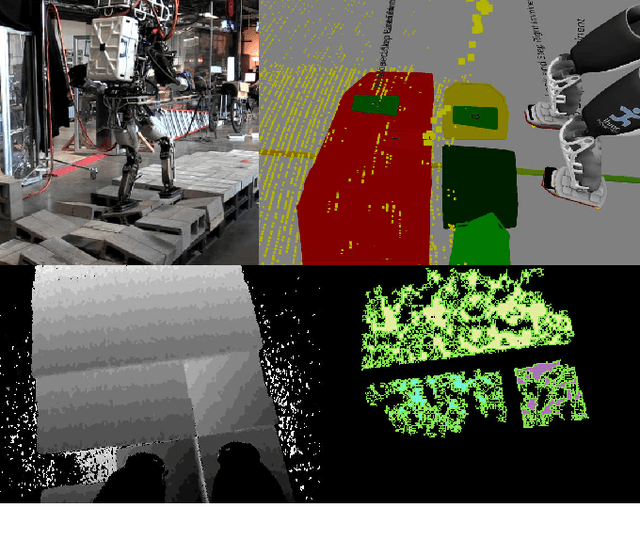
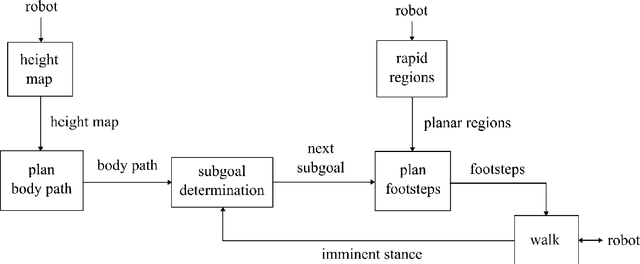
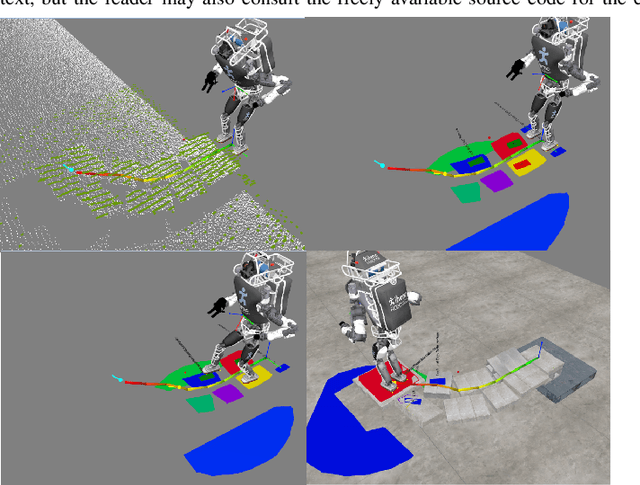
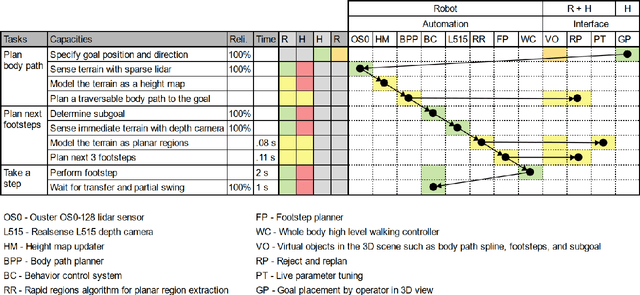
Abstract:In trying to build humanoid robots that perform useful tasks in a world built for humans, we address the problem of autonomous locomotion. Humanoid robot planning and control algorithms for walking over rough terrain are becoming increasingly capable. At the same time, commercially available depth cameras have been getting more accurate and GPU computing has become a primary tool in AI research. In this paper, we present a newly constructed behavior control system for achieving fast, autonomous, bipedal walking, without pauses or deliberation. We achieve this using a recently published rapid planar regions perception algorithm, a height map based body path planner, an A* footstep planner, and a momentum-based walking controller. We put these elements together to form a behavior control system supported by modern software development practices and simulation tools.
Humanoid Path Planning over Rough Terrain using Traversability Assessment
Mar 01, 2022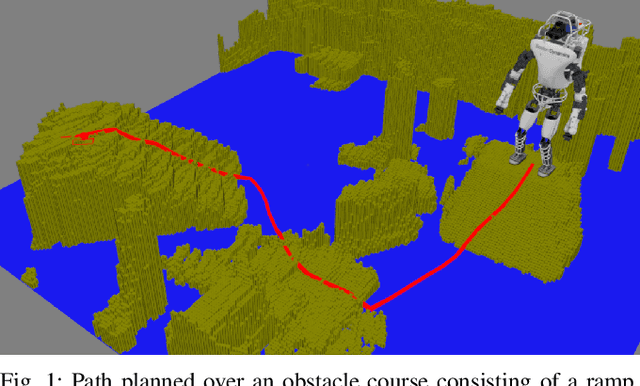
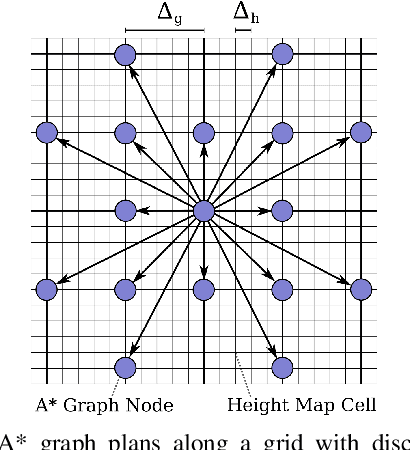
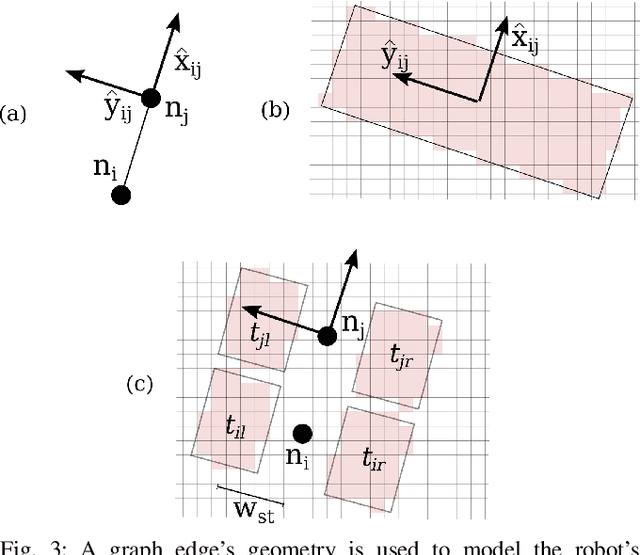
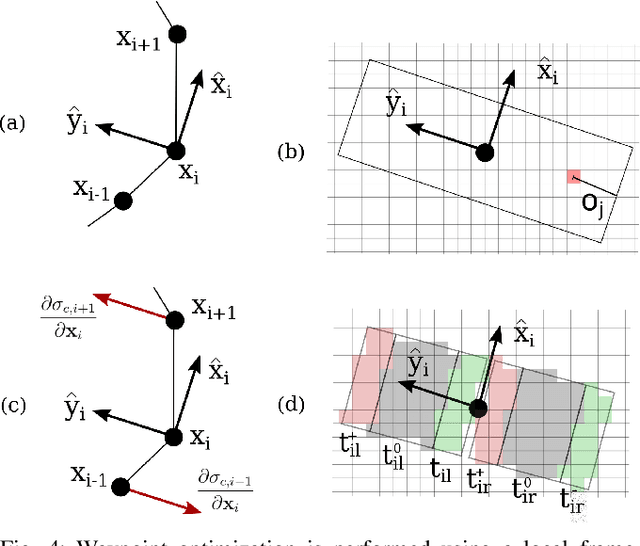
Abstract:We present a planning framework designed for humanoid navigation over challenging terrain. This framework is designed to plan a traversable, smooth, and collision-free path using a 2.5D height map. The planner is comprised of two stages. The first stage consists of an A* planner which reasons about traversability using terrain features. A novel cost function is presented which encodes the bipedal gait directly into the graph structure, enabling natural paths that are robust to small gaps in traversability. The second stage is an optimization framework which smooths the path while further improving traversability. The planner is tested on a variety of terrains in simulation and is combined with a footstep planner and balance controller to create an integrated navigation framework, which is demonstrated on a DRC Boston Dynamics Atlas robot.
Deploying the NASA Valkyrie Humanoid for IED Response: An Initial Approach and Evaluation Summary
Oct 02, 2019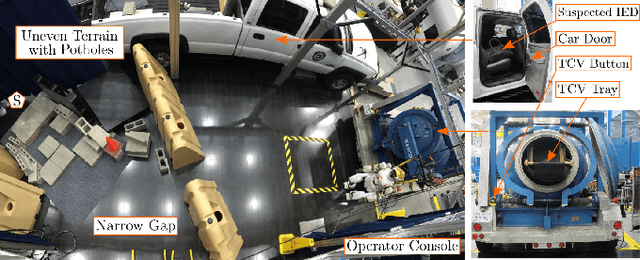
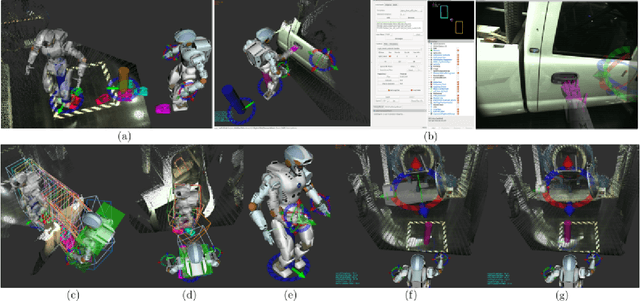
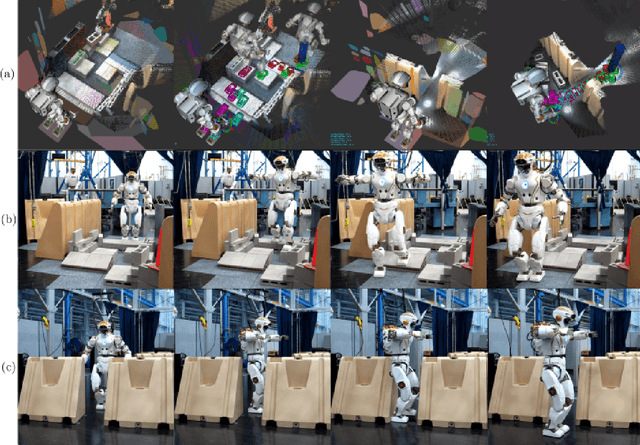
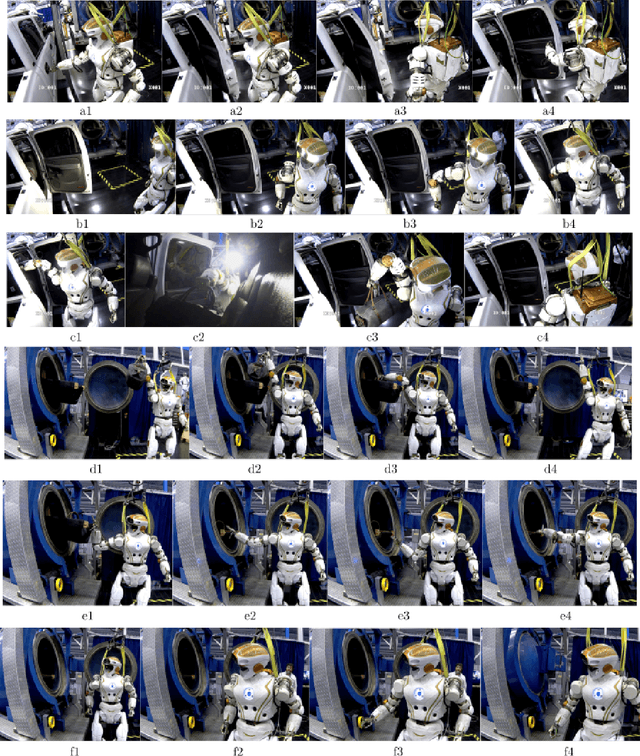
Abstract:As part of a feasibility study, this paper shows the NASA Valkyrie humanoid robot performing an end-to-end improvised explosive device (IED) response task. To demonstrate and evaluate robot capabilities, sub-tasks highlight different locomotion, manipulation, and perception requirements: traversing uneven terrain, passing through a narrow passageway, opening a car door, retrieving a suspected IED, and securing the IED in a total containment vessel (TCV). For each sub-task, a description of the technical approach and the hidden challenges that were overcome during development are presented. The discussion of results, which explicitly includes existing limitations, is aimed at motivating continued research and development to enable practical deployment of humanoid robots for IED response. For instance, the data shows that operator pauses contribute to 50\% of the total completion time, which implies that further work is needed on user interfaces for increasing task completion efficiency.
 Add to Chrome
Add to Chrome Add to Firefox
Add to Firefox Add to Edge
Add to Edge